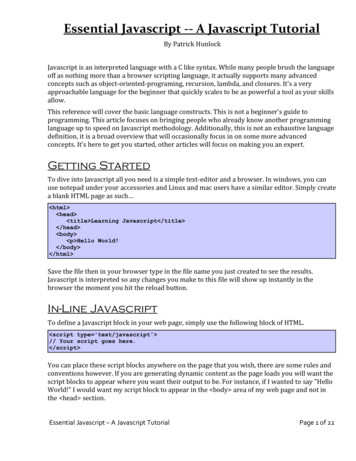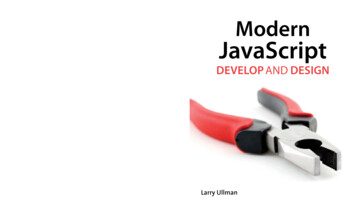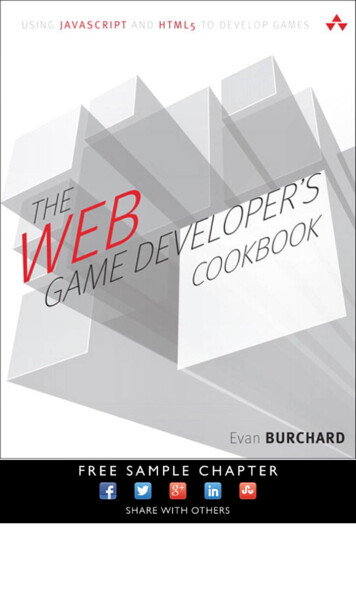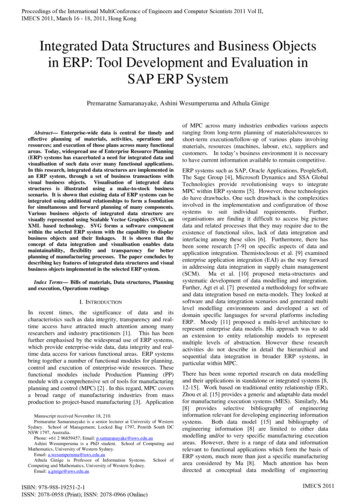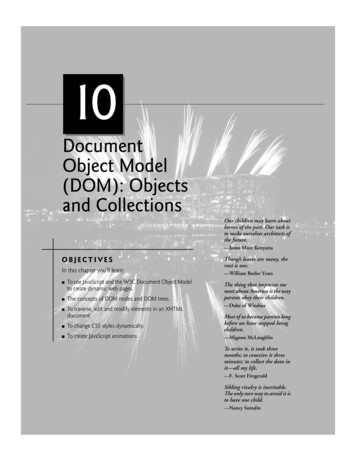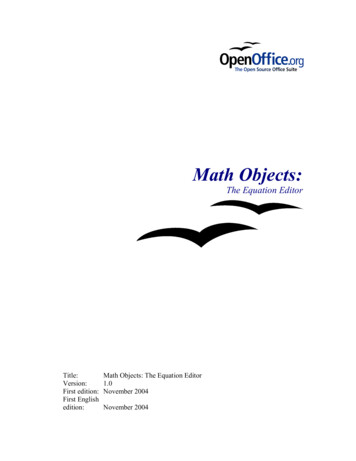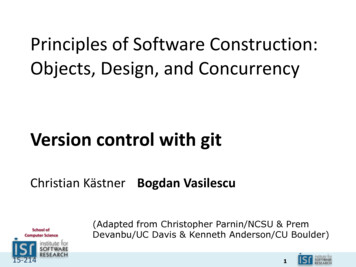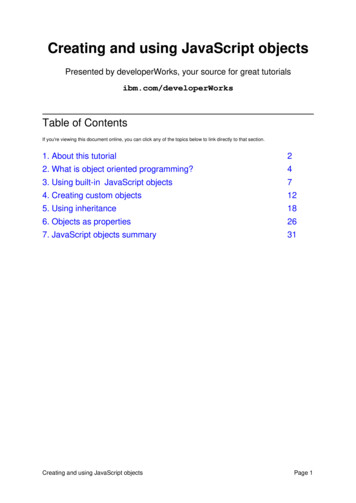
Transcription
Creating and using JavaScript objectsPresented by developerWorks, your source for great tutorialsibm.com/developerWorksTable of ContentsIf you're viewing this document online, you can click any of the topics below to link directly to that section.1. About this tutorial22. What is object oriented programming?43. Using built-in JavaScript objects74. Creating custom objects125. Using inheritance186. Objects as properties267. JavaScript objects summary31Creating and using JavaScript objectsPage 1
Presented by developerWorks, your source for great tutorialsibm.com/developerWorksSection 1. About this tutorialShould I take this tutorial?This tutorial is for programmers who wish to take advantage of object oriented programming(OOP) using JavaScript -- either within the browser or on the server side -- by usingcustom-built JavaScript objects and their properties and methods.This tutorial assumes that you already understand JavaScript in general, and that you haveat least a familiarity with built-in objects such as document, though the basics are reviewedin the tutorial. An understanding of OOP is helpful, but not required, as the basic requiredconcepts are also covered in this tutorial. (References to further information on thesesubjects are also included in Resources on page 31.)What is this tutorial about?Object oriented programming (OOP) is a means for dividing a program into objects withpredefined properties and behaviors, known as methods. JavaScript is frequently used moreas a procedural language, where a script proceeds through a series of steps. However, it isat heart an object oriented language (similar to other object oriented languages, such asJava or C ) which can be used to create objects.This tutorial explains the very basics of OOP and how to use it within JavaScript. Conceptsare covered by using the built-in JavaScript objects many programmers already use. Theseconcepts are then extended to cover custom objects you can create yourself.This tutorial covers the creation of objects, the nesting of objects within one another as oneobject becomes the property of another, and the creation of properties and methods(including dynamically created methods). It also explains how one JavaScript object caninherit the properties and methods of another, and how to alter the structure of an object afterit has been created.ToolsThis tutorial helps you understand the topic even if you only read through the exampleswithout trying them out. If you do want to try the examples as you go through the tutorial,make sure you have the following tools installed and working correctly:**A text editor: HTML pages and the JavaScript sections within them are simply text. Tocreate and read them, a text editor is all you need.Any browser capable of running JavaScript version 1.2 or above: This includesNetscape Navigator 4.7x and 6.2 (available athttp://browsers.netscape.com/browsers/main.tmpl ) and Microsoft Internet Explorer 5.5(available from ive/default.asp ).About the authorCreating and using JavaScript objectsPage 2
Presented by developerWorks, your source for great tutorialsibm.com/developerWorksNicholas Chase has been involved in Web site development for companies including LucentTechnologies, Sun Microsystems, Oracle Corporation, and the Tampa Bay Buccaneers. Nickhas been a high school physics teacher, a low-level radioactive waste facility manager, anonline science fiction magazine editor, a multimedia engineer, and an Oracle instructor. Morerecently, he was the Chief Technology Officer of Site Dynamics Interactive Communicationsin Clearwater, Fla. He is the author of three books on Web development, including Java andXML From Scratch (Que). He loves to hear from readers and can be reached atnicholas@nicholaschase.com .Creating and using JavaScript objectsPage 3
Presented by developerWorks, your source for great tutorialsibm.com/developerWorksSection 2. What is object oriented programming?Procedural programmingMost programmers learn their craft by creating programs that proceed more or lesssequentially: Do this, do this, do this, then if this is true, do that. Sometimes these programsbranch off into modularized sections such as subroutines and procedures. For the most part,however, data is global in nature, meaning that any section of the program can modify it, anda small change in one section of code can have a profound effect in other parts.This style of programming, known as procedural programming, has been around since thebeginning. While there is nothing inherently wrong with it, in many cases there are betterways to get things done.Object oriented programmingConsider a trip to the grocery store with a very specific list of items to pick up. A proceduralprogram for this trip must attempt to find each item, determine the correct brand and size ifit's located, and determine an alternative if it's not. Each item must then be put into the cart,and when the list has been processed, checked out. None of this is particularly daunting, ofcourse, but what about taking into account distractions, such as knocking over a jar ofpickles, or running into your first grade teacher? Because of the variety of distractions andenvironments in which they can occur, adding the capability to handle the distraction and goback to shopping in a procedural language can have a major impact on the application as awhole.Object oriented programming provides a different way of thinking about this problem. Insteadof constructing a series of steps, the programmer creates a series of objects that all knowhow to behave when various things happen. The Shopper object knows how to search for aparticular Item object, and if that's located, the Shopper can initiate the process of putting itinto the cart. (It might also know that if the Item cannot be located, it should use the Phoneobject to query the Wife object for a replacement Item.) When the time comes, theShopper object also knows how to work with the Cashier object to check out the groceries.The advantage here is that all the Shopper knows about, say, the Cashier, is how tointeract with it, such as to present it with a series of Item objects to check out. If the processfor checking out an Item changes -- with a new scanning system, for example -- theShopper object isn't affected. All of those changes are taken care of within the Cashierobject. Similarly, adding the capability for dealing with Distraction objects is taken care ofwithin the Shopper object, without major impact to the rest of the application.In its simplest form, OOP is a way of incorporating information and behaviors into objects sothat they can interact with each other to get a particular job done.What is an object?An object is a collection of data and behaviors, or information about what it is and what itdoes. Slight differences between languages exist, but in general these are known,respectively, as properties and methods.Creating and using JavaScript objectsPage 4
Presented by developerWorks, your source for great tutorialsibm.com/developerWorksA Shopper object might have properties that provide information such as name, amount ofavailable cash, debit card PIN number, and where the car is parked. These properties aretypically designated as private, which means that they are kept within the object andaccessed only through methods.For example, the Shopper's name may be accessible through the getName() method. Intraditional OOP, properties generally have get and set methods to allow for read and writeaccess, as appropriate. (JavaScript allows for the creation of these methods, but it does notallow for the designation of private data, so it is much more common to access propertiesdirectly.)The Shopper object may also have methods that provide for specific functionality, such assearchForItem() and useCoupon(), or methods that provide a way for other objects tointeract with it, such as payBill(). The methods that are made available for other objectsto call make up an object's interface.InterfacesAn object's interface is the collection of methods through which other objects can interactwith it. For example, the Item object may have getPrice(), getUnitPrice(),showCoupons(), and addToCart() methods that the Shopper object can call.Notice, however, that there is no setPrice() method available to the Shopper object. Thatmakes sense, because the Shopper shouldn't be able to set the price. Naturally, thisfunctionality must exist somewhere, perhaps in a method that is only available to theManager object. But in a traditional OOP application, this isolation provides a way to controlaccess to data, limiting the amount of damage that can be done by any one section of theapplication.Again, JavaScript doesn't actually provide a way to isolate that data, but you can achieve thiseffect if you make a habit of only referring to properties through these methods.InheritanceOne major aspect of OOP is inheritance. Inheritance is the ability to base one type of objecton another type of object. For instance, an Item might be the basis for SaleItem andHeavyItem objects. Both are Items, but each has its own idiosyncrasies.The advantage of using inheritance is that the base properties and methods of the originalobject can be retained while any extras or differences can be added. For example, all Itemsmay have a price property (or a getPrice() method), but a SaleItem also needs anoriginalPrice property (or a getOriginalPrice() method).HeavyItem, on the other hand, may not need any extra properties or methods, but itrequires changes to the addToCart() method to accommodate the fact that it needs to beplaced at the bottom of the cart, and not to the actual basket.In both of these cases, the original Item methods and properties take precedence unlessthey are superseded by new properties and methods. For example, when the applicationcalls addToCart(), what happens next depends on the object involved. If the ItemCreating and using JavaScript objectsPage 5
Presented by developerWorks, your source for great tutorialsibm.com/developerWorksinvolved is a HeavyItem, the application uses the HeavyItem version of addToCart(),and adds it to the bottom. On the other hand, if it is a SaleItem, the application doesn't finda local version of addToCart(), so it uses the Item version.ConstructorsA constructor is a routine that is executed when an object is first created in memory for useby the application. For example, when a new Cashier is created (i.e., when another registeropens) certain steps need to be taken. The register is activated, the light is turned on, andthe Cashier announces, "I can take the next person in line ."Constructors can be general, as in the previous example, or they can be more specific, as inan Item constructor that takes in an identifier such as a Product Look-Up (PLU) and uses itto set the values for properties such as price and unit price.In some languages, an object may have more than one constructor. For example, theCashier may have been sent to open the first available register, or the Cashier may havebeen sent to open a specific register, in which case the constructor would take the registernumber as an argument, overloading the constructor.Unfortunately, JavaScript doesn't support overloading. However, it does allow for the buildingof constructors with some of the same logic to take into account optional arguments.Classes vs. prototypes vs. objectsThose who have worked with OOP languages -- particularly Java -- in the past may bewondering why the discussion so far has specifically avoided using the word class whendescribing objects.In traditional OOP, a class is a template for an object. It lists the properties and methods forthe object and provides implementations for those methods. The object itself is an instanceof that class. For example, the objects joe, mary, and frank may be instances of theShopper class. The application deals with these instances, which are built with guidancefrom the class. Java is one example of a class-based language.In a class-based language, the classes are typically defined when the class is compiled.Once an instance is created within an application, adding or removing properties or methodsis impossible.JavaScript, on the other hand, is a prototype-based language. In a prototype-basedlanguage, the objects that are based on a prototype remain connected to it. New propertiesand methods can be added both to an individual instance and to the prototype on which it isbased. If the definition of the prototype changes, all objects based on that prototype changeas well.This change in ideology provides a great deal of flexibility. For example, a programmer canadd elements to an HTML page programmatically using the built-in JavaScript objects.Creating and using JavaScript objectsPage 6
Presented by developerWorks, your source for great tutorialsibm.com/developerWorksSection 3. Using built-in JavaScript objectsThe document object: using methodsIf you've worked with JavaScript, you have undoubtedly used objects already, even if theyare just the objects that are already built into the language (and the browser). Use of customobjects is identical to use of these built-in objects in many ways, so it helps to look criticallyat how they are used and how they are structured.The most common and most basic object used in JavaScript is the document itself. Inaddition to providing a reference point for many other built-in objects (as discussed in thenext panel) the document object has several useful methods.The most useful of these is the write() method, which enables the output of information tothe browser page. This information may be static text, or it may be variables or other objectproperties or methods. For example: script type "text/javascript" document.write('Hello there!')document.write(' br / ')document.write('Today is) /script In this example, the write() method of the document object outputs information to thepage. Note the format: object name, dot (.), method name, and arguments in parentheses.The document object: propertiesA script also accesses an object's properties using dot notation. For example: script type "text/javascript" .document.write('This document is: '. br / ') /script Creating and using JavaScript objectsPage 7
Presented by developerWorks, your source for great tutorialsibm.com/developerWorksIn JavaScript, any information about an object is considered a property, whether it isinformation about the location of the document object (as shown in the above example), orinformation on how to do something. In other words, methods are also considered propertiesof an object, because they provide information (in this case, about what the object shoulddo).An object property can also contain another object. For example, the document object isactually a property of the window object, and in turn has many properties that are objects. Infact, in a well-formed document, the entire content of the page can be referenced from withinthe document object. The structure of the information depends on the HTML elementsinvolved.Objects as properties: form elementsOne common use for the chain of objects and properties involves form elements. JavaScriptis often used to validate a form before it is submitted. In order to do that, the script must beable to access the various elements that are part of the form. Consider the following form: form id "sampleForm" name "sampleForm" action "bogus.asp" method "post" Please enter your name: input type "text" name "yourName" / br / Please choose a flavor: select name "flavor" option value "no choice" Please Choose . /option option value "chocolate" Chocolate /option option value "vanilla" Vanilla /option /select br / input type "button" onclick "checkForm()" value "Submit Form" / /form Creating and using JavaScript objectsPage 8
Presented by developerWorks, your source for great tutorialsibm.com/developerWorksThis form, sampleForm, is a property of the document object, and itself has properties, asseen below: script type "text/javascript" function checkForm(){var confirmString 'You entered: \n Name ' document.sampleForm.yourName.value "\n" 'Flavor ' document.sampleForm.flavor.value '(' document.sampleForm.flavor.selectedIndex ")" '\n\n OK? 'if (confirm(confirmString)) {document.sampleForm.submit()} else {alert('Please adjust your answers.')}} /script Here the sampleForm form object is referenced as a property of the document object. ThesampleForm object itself has properties that are objects with their own properties, such asthe yourName and flavor form element objects.The sampleForm object also has methods, such as the submit() method called within theif-then statement. Like the other properties, this method can be accessed from thedocument object by walking down the chain of objects.Arrays of properties: formsSometimes the object being referenced is not a simple value or object, but an array of valuesor objects. For example, a page might have more than one form on it. In that case, the scriptcan access it using the zero-based array of forms, as in:Creating and using JavaScript objectsPage 9
Presented by developerWorks, your source for great lavor.valueThe script can also refer to the form as part of an associative array, which uses the name ofthe object instead of the roperties can also be accessed as part of an associative array, where the name of theobject acts as the index. For ment.sampleForm.flavor['selectedIndex']This flexibility allows you to decide programmatically what properties to retrieve, then usevariables to determine the associative array index.Creating objects: the Image prototypeAll of the objects seen so far have been automatically created by the browser, but objectscan also be created explicitly. Not all of these objects have to be custom objects, however.Many objects are already defined, such as the Date, History, and various form-relatedobjects, such as Text and Button.One object that gets a lot of use is the Image object. The browser knows that an Imageobject is normally displayed on the page, and it knows how to do that by referencing the srcproperty to find out what image to display. In many cases, such as image rollover animations,the browser references an Image object that was created through the HTML code on thepage. By changing the value of the src property, the script changes what appears on thepage.An Image object can also be created independent of the HTML. Unless the script explicitlyadds it to the page, it won't be displayed, but the browser still tries to load the imagereferenced by the src property. Web authors often use this to preload images into thebrowser's cache, so they are available instantly when needed, such as for a rolloveranimation.To do this, a new object must be created using the Image object as its prototype. The srcproperty for that object can then be accessed:var preLoader new Image()preLoader.src 'images/bluto.gif'preLoader.src 'images/pyramid.jpg'preLoader.src 'http://www.example.com/images/plants.jpg'The preLoader object is created just like any other JavaScript variable, but its value is setas the returned value from the Image() constructor. The preLoader then exists as anobject with all of the properties and methods of the Image prototype, so the script can set thesrc property.Custom objects are created in much the same way.Creating and using JavaScript objectsPage 10
Presented by developerWorks, your source for great tutorialsCreating and using JavaScript objectsibm.com/developerWorksPage 11
Presented by developerWorks, your source for great tutorialsibm.com/developerWorksSection 4. Creating custom objectsA simple object and constructorThe foundation of any object is the creation of a constructor. A constructor is the code thatactually creates a new instance of an object. The constructor can be simple, setting one ormore property values. Consider the example of a project tracking application. Theconstructor for a Project object needs to set certain information:function Project() {this.name "Miracle Preso"this.manager "Alex Levine"this.status 0}The this keyword refers to whichever object is the current object when the function iscalled. When the script calls the function as a constructor, the this keyword refers to thenew object being created.Actually creating the object is just like creating an Image object, as in the previous panel:var miracle new Project()The variable (in this case miracle) is now a new Project object, just as preLoader wasa new Image object in the previous panel.Accessing object propertiesOnce the object has been created, the script can access its properties just as it accessed theproperties of built-in objects:function Project() {this.name "Miracle Preso"this.manager "Alex Levine"this.status 0}var miracle new Project()document.write('Name: ' miracle.name)document.write(' br / ')document.write('Project Manager: ' miracle.manager)document.write(' br / ')document.write('Status: ' miracle.status)Each of these values has been set within the constructor, so it is accessible via its propertyCreating and using JavaScript objectsPage 12
Presented by developerWorks, your source for great tutorialsibm.com/developerWorksname.Changing object propertiesJust as a script accesses object properties through dot notation, it can make modifications tothose properties:var miracle new Project()miracle.name "Save the Trees"miracle.manager "Connie Gibbons"document.write('Name: ' miracle.name)document.write(' br / ')document.write('Project Manager: ' miracle.manager)document.write(' br / ')document.write('Status: ' miracle.status)Because only Name and Manager were altered, Status retains its original value.In traditional OOP, it's customary to use methods to get and set property values, but directaccess is common in JavaScript.Optional constructor argumentsJavaScript does not, unfortunately (or fortunately, depending upon whom you ask), supportoverloading of functions, so constructors must be built with all possible combinations in mind.The most common permutations involve using arguments as values if they exist, and usingdefault values if they don't. A constructor can accomplish this using if-then statements, asin:function Project(projName, projMgr, projStatus) {if (projName null) {this.name "Miracle Preso"} else {this.name projName}if (projMgr null) {this.manager "Alex Levine"} else {this.manager projMgr}if (projStatus null) {Creating and using JavaScript objectsPage 13
Presented by developerWorks, your source for great tutorialsibm.com/developerWorksthis.status "0%"} else {this.status projStatus}}Optional constructor arguments (continued)It can be much more convenient, however, to use "or" notation. Consider the followingexpression:expr1 expr2If expr1 is non-null, the "or" condition is satisfied, and that is the returned value. On theother hand, if expr1 is null, the script goes on to evaluate expr2. If it is not null, then that isthe value returned.Translating this concept to the Project() constructor:function Project(projName, projMgr, projStatus) {this.name projName "Miracle Preso"this.manager projMgr "Alex Levine"this.status projStatus "0%"}var miracle new Project()var kennel new Project('Kennel Club', 'Jack Ramsey', '25%')document.write('Miracle: br / ')document.write('--- Name: ' miracle.name ' br / ')document.write('--- Project Manager: ' miracle.manager ' br / ')document.write('--- Status: ' miracle.status ' br / br / ')document.write('Kennel: brdocument.write('--- Name: 'document.write('--- Projectdocument.write('--- Status:/ ') kennel.name ' br / ')Manager: ' kennel.manager ' br / ')' kennel.status ' br / br / ')In this example, two objects are created from the same constructor. The miracle objectdidn't provide arguments, and gets the default values. The kennel object, on the other hand,gets the arguments as property values.Creating and using JavaScript objectsPage 14
Presented by developerWorks, your source for great tutorialsibm.com/developerWorksAdding methodsStrictly speaking, a JavaScript object method is simply a property that contains a function.When the property is accessed, the function executes.The simplest methods are used to change the properties of an object. In JavaScript, it iscommon to change these properties directly, but they can also be changed through methods.Consider a method that's used to set the status of the Project:function setStatus(newStatus) {this.status newStatus}To create the method, assign the function to a property:function Project(projName, projMgr, projStatus) {this.name projName "Miracle Preso"this.manager projMgr "Alex Levine"this.status projStatus "0%"this.setStatus setStatus}Note that the names don't have to be the same, though it can make the code easier tounderstand. Notice also that although the code refers to a function, it doesn't haveparentheses after it (as in setStatus()).To call the method, simply reference the property, along with any parameters:var kennel new Project('Kennel Club', 'Jack Ramsey', '25%')document.write('Kennel: brdocument.write('--- Name: 'document.write('--- Projectdocument.write('--- Status:/ ') kennel.name ' br / ')Manager: ' kennel.manager ' br / ')' kennel.status ' br / br / ')kennel.setStatus('45%')document.write('New status: ' kennel.status)Methods can also serve much more complex purposes, but their construction and access arethe same in any case.Array propertiesCreating and using JavaScript objectsPage 15
Presented by developerWorks, your source for great tutorialsibm.com/developerWorksIn some situations, one property holds multiple pieces of data. For example, a project mayhave multiple team members. To add them as individual items in a single property, use anarray:function Project(projName, projMgr, projStatus) {this.name projName "Miracle Preso"this.manager projMgr "Alex Levine"this.status projStatus "0%"this.team ["John Smith", "Mary Jones", "August McKendrick"]this.setStatus setStatus}To access the individual values, add an index value to the property:var kennel new Project('Kennel Club', 'Jack Ramsey', (' br / ')document.write(kennel.team[1])document.write(' br / ')document.write(kennel.team[2])Modifying an objectOne of the advantages of a prototype-based language over a class-based language is theability to change not only an object, but an entire type of object, after it has been created. Forexample, suppose an auditor needs to be added to projects because they have been stalledfor a certain amount of time. Adding a property to a single object is easy. Simply reference itand assign it a value:kennel.auditor "Janine Gottfried"document.write('Miracle Auditor: ' miracle.auditor)document.write(' br / ')document.write('Kennel Auditor: ' kennel.auditor)Because the value has been specifically assigned to the kennel object, the miracle objectis not affected.But what if an overall lack of progress means that auditors should be assigned to allprojects? If the change is applied to the prototype of the kennel object, all objects based onCreating and using JavaScript objectsPage 16
Presented by developerWorks, your source for great tutorialsibm.com/developerWorksthat prototype will be affected:Project.prototype.auditor "Janine Gottfried"document.write('Miracle Auditor: ' miracle.auditor)document.write(' br / ')document.write('Kennel Auditor: ' kennel.auditor)Because the change is applied to the Project prototype, it affects all Project objects.JavaScript also allows for the deletion of properties. For example:delete kennel.auditordelete Project.prototype.auditorThe rules regarding propagation of deleting a property are the same as those for adding aproperty.Creating and using JavaScript objectsPage 17
Presented by developerWorks, your source for great tutorialsibm.com/developerWorksSection 5. Using inheritanceAdding inherited objectsThe running project tracking application example has established a basic type of object, theProject. This is, of course, an extremely general object. Projects usually haverequirements specific to themselves, or at least specific to the type of project at hand.Take, for example, three types of interactive media projects: a Web site, a CD-ROM, and akiosk. All three have the same requirements as a general project: a name, a projectmanager, a status, and a team of employees working on it. Each also has specificrequirements. For example, a Web site project also has a base URL, a CD-ROM has atarget platform, and a kiosk has a target input device, such as a keyboard or a touch screen.All of these objects are, however, Project objects, so it makes sense to extend theProject object when creating them.Using a prototypeThe first step in creating new objects is to determine their prototype. In absence of otherdeclarations, JavaScript uses the generic Object object, but the Project object can beexplicitly set as the prototype for the new objects:WebSite.prototype new Projectfunction WebSite(webSiteURL) {this.URL webSiteURL "http://www.example.com"}In this way, when the script creates a new WebSite object, it has not only the originalproperties of the Project object, but also the additional URL property:var kennel new WebSite()document.write('Name: ' kennel.name)document.write(' br / ')document.write('Project Manager: ' kennel.manager)document.write(' br / ')document.write('Status: ' kennel.status)document.write(' br / ')document.write('URL: ' kennel.URL)Even though no name, ma
This tutorial is for programmers who wish to take advantage of object oriented programming (OOP) using JavaScript -- either within the browser or on the server side -- by using custom-built JavaScript objects and their properties and methods. This tutorial assumes that you already understand

